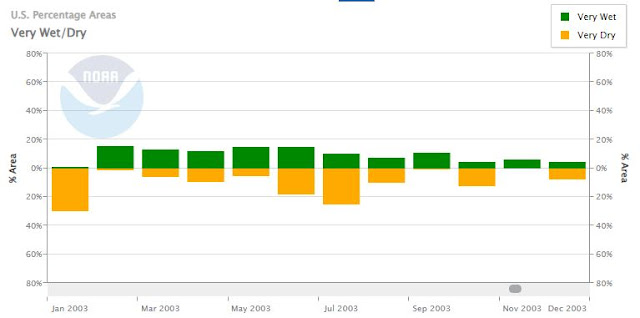- Global atmospheric CO2 concentration: 375.15 ppm, +2.56 ppm from 2002
- Average air temperature: 54.9°F, 24th all-time 1894-2021
- Average precipitation: 28.13”, 25th driest 1894-2021
- Tornadoes: 1384, above the 1991-2010 average 1228
- 16 named tropical cyclones: 7 became hurricanes, 3 major (winds > 111 mph, 3-5 Saffir-Simpson)
- ENSO: Moderate El Niño through April, neutral from then till year’s end
North American Conditions
- Warmer than average: almost all of Canada; western US
- Drought: northeastern Mexico, western US, Canadian prairies; up to 33% of the US in midsummer
- Precipitation: eastern US wetter than average; rainfall in Canada 1.8% above average; western US below average
- Wildfire: 1.5 x 106 hectares (ha) (3.7 x 106
acres) burned, 80% of 1992-2002 average.
State-by-state historical rankings, 2003 temperature.
The 1961-1990 average for named storms in the North Atlantic
is 9.8. The 2003 total of 16 is close to double that, and continued the 1990’s
trend of highly active hurricane seasons. NOAA characterizes seasonal hurricane
activity with the Accumulated Cyclone Energy (ACE) index, which estimates wind
energy by squaring the hourly sustained wind speed for every tropical
storm/hurricane. The ACE is the sum total of all squared wind speeds, across
all storms, for the season. 2003’s ACE was 174.75 x 104 kt2,
almost exactly double the 1951-2000 median value of 87.5 x 104 kt2.
State-by-state historical rankings, 2003 precipitation.
The El Niño which began the year, and the negative NAO
(smaller Atlantic pressure anomalies meaning a lower pressure gradient from
south to north) combined to bring consistent precipitation to the east coast
and southeastern region of the US, including a snowy 2002-03 winter. Snowfall
in the west was not far below normal, as opposed to the extreme warmth and
dryness of the summer. Mexico likewise had drought conditions for much of the
year, though late-season tropical storms alleviated this in the central eastern
region of the country.
2003 Percentage of US very warm vs. very cold.
Europe experienced above-average temperatures all year, with record-breaking heat through the summer months, especially in the western countries. This heat wave resulted more than 11,000 deaths in France alone. Alpine glaciers lost an estimated 3 m of ice thickness, nearly twice the 1998 record for melting. At the same time, precipitation was well below average.
2003 Percentage of US very dry vs. very wet.
Tomorrow: 2003 State of the World Climate.
Be brave, and be well.









No comments:
Post a Comment